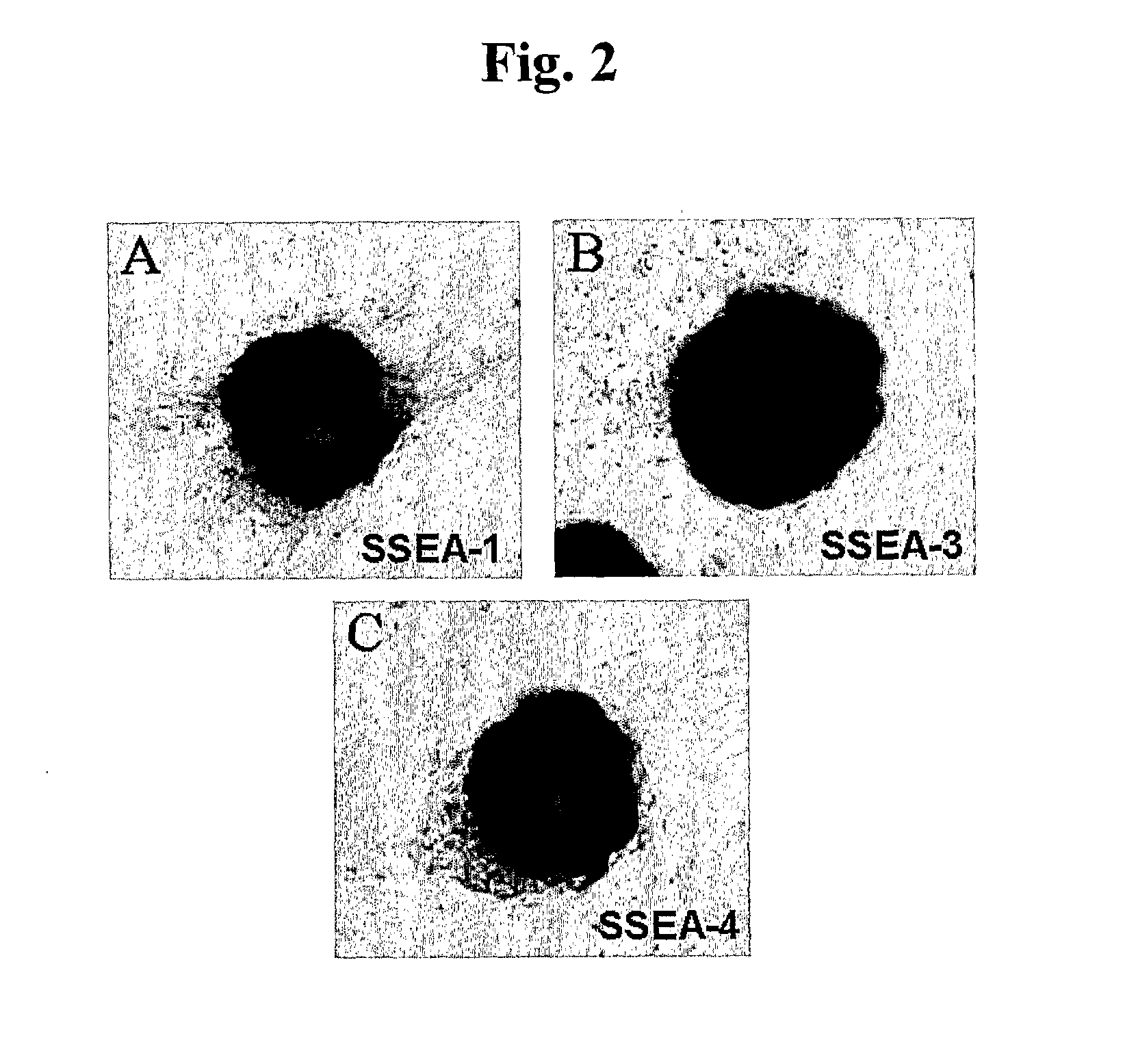In Vitro Method for Isolating, Proliferating and Differentiating Germ-Line Stem Cells
a germ-line stem cell and in vitro culture technology, which is applied in the field of isolating, proliferating and differentiating mammalian male germ-line stem cells, can solve the problems of insufficient completion of the technical system allowing the mass proliferation of germ-line stem cells by in vitro culture, potential risks in the clinical use of round spermatids produced from immortalized cells, and insufficient isolation of germ-line stem cells. to achieve the effect of isolation and proliferation of germ-line stem
- Summary
- Abstract
- Description
- Claims
- Application Information
AI Technical Summary
Benefits of technology
Problems solved by technology
Method used
Image
Examples
example 1
Isolation and Proliferation of Germ-Line Stem Cells from Male Mice
[0080] Germ-line stem cells were isolated from the testis of thirty 3˜5-day-old male C57BL / 6 or ICR mice (Korea Biolink Co.) and proliferated.
[0081] First, in order to isolate seminiferous tubules from male mice, the following two-step enzymatic digestion process (Ogawa et al., Int. J. Dev. Biol., 41:111-122, 1997) was performed.
[0082] Namely, testis were extracted from the mice and washed with PBS, and the tunica albuginea was removed from the testis. Seminiferous tubules, which are exposed in the testis, were collected and incubated in 10 ml of a first enzyme solution containing 0.5 mg / ml of collagenase (Type I, Sigma), 10 μg / ml of DNase I, 1 μg / ml of soybean trypsin inhibitor (Gibco, Grand Island, N.Y.), 1500 U / ml of leukemia inhibitory factor (ESGRO) and 1 mg / ml of hyaluronidase (Sigma) in Ca2+ and Mg2+-free PBS at room temperature for 20 minutes. Then, PBS was added to the first enzyme solution and it was cent...
example 2
Isolation and Proliferation of Germ-Line Stem Cells from Human Azoospermia Patients
[0097] Germ-line stem cells were isolated from the testis of 13 human non-obstructive azoospermia patients and proliferated.
[0098] First, in order to isolate seminiferous tubules from the 13 patients, a portion of the testicular tissue was extracted by biopsy and subjected to the two-step enzymatic digestion process in the same manner as in Example 1.
[0099] The pellets produced by above method were attached and cultured on a culture dish coated with 0.2% gelatin. A culture medium was DMEM (Dulbecco's modified Eagle's medium; GIBCO) supplemented with 15% fetal bovine serum (HyClone), 1% nonessential amino acid (GIBCO), 10 μM 2-mercaptoethanol, 1500 U / ml of human leukemia inhibitory factor (ESGRO), 4 ng / ml of bFGF(R&D) and 10 μM forskolin (Sigma). Also, the culture was performed in an incubator maintained at 5% CO2 and 95% humidity. After 2-4 week culturing, a number of multicellular colonies and Ser...
example 3
In Vitro Differentiation from Germ-Line Stem Cells into Haploid Germ Cells
[0113] The isolated and proliferated germ-line stem cells were differentiated into germ cells by in vitro culture.
[0114] Namely, the germ-line stem cells and Sertoli cells of mice and human non-obstructive azoospermia patients, which have been isolated and proliferated in Examples 1 and 2, respectively, were separated into single cells by treatment with trypsin, and resuspended, followed by encapsulation with sodium alginate (Lee et al., Biol. Reprod. 65: 873-878, 2001).
[0115] Then, the encapsulated cells were transferred to 1.0 ml of a culture medium without peritubular cell monolayers as feeder cells in 24-well dish, and cultured in an incubator (maintained at 5% CO2 and 95% humidity) at 32° C. for 7 weeks. During culture, the culture medium was replaced every two day. The culture medium was a HEPES-buffered DMEM / F12 medium supplemented with 10 μg / ml of insulin-transferrin-selenium solution (Gibco), 10−4 ...
PUM
| Property | Measurement | Unit |
|---|---|---|
| diameter | aaaaa | aaaaa |
| humidity | aaaaa | aaaaa |
| humidity | aaaaa | aaaaa |
Abstract
Description
Claims
Application Information
 Login to View More
Login to View More - R&D
- Intellectual Property
- Life Sciences
- Materials
- Tech Scout
- Unparalleled Data Quality
- Higher Quality Content
- 60% Fewer Hallucinations
Browse by: Latest US Patents, China's latest patents, Technical Efficacy Thesaurus, Application Domain, Technology Topic, Popular Technical Reports.
© 2025 PatSnap. All rights reserved.Legal|Privacy policy|Modern Slavery Act Transparency Statement|Sitemap|About US| Contact US: help@patsnap.com



